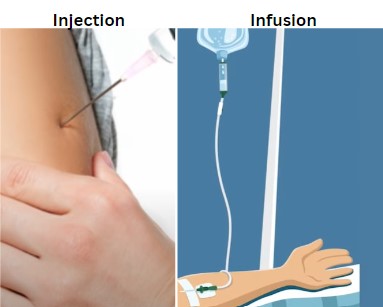When exploring medical procedures, it’s important to understand the difference between injections and infusions. Injections are quick, while infusions have controlled release. Both techniques give healthcare professionals versatile tools to address different clinical needs. By knowing how to use them properly, we can improve patient care and treatment outcomes.

Basic Difference between injection and infusion
injections:
injection refers to the direct delivery of a medicament into the body, typically through a syringe or a similar device. This method uses for the administration of medications, vaccines, or therapeutic agents, ensuring rapid absorption into the bloodstream. With injections, medical professionals can achieve precise dosing and targeted delivery, optimizing therapeutic outcomes. Additionally, injections are often preferred for medications that require immediate effect or substances that may be rendered ineffective by alternative administration routes.
Examples of Injection and their Routes:
Intramuscular (IM) Injection:
- Vaccines (e.g., influenza, tetanus)
- Antibiotics (e.g., penicillin, cephalosporins)
- Hormones (e.g., testosterone, progesterone)
Subcutaneous (SC) Injection:
- Insulin for diabetes management
- Epinephrine for severe allergic reactions (e.g., EpiPen)
- Low molecular weight heparin for anticoagulation
Intravenous (IV) Injection:
- Antibiotics (e.g., vancomycin, ceftriaxone)
- Chemotherapy drugs for cancer treatment
- Intravenous fluids for hydration
infusions:
infusions involve a different approach altogether. An infusion entails the gradual introduction of fluids, medications, or nutrients directly into the bloodstream over a specific duration. Unlike injections, which offer rapid delivery, infusions provide a continuous, controlled release of substances. Such a technique is particularly advantageous for treatments requiring a sustained therapeutic effect or those necessitating a steady infusion rate. Intravenous (IV) drips, for instance, exemplify the concept of infusions, enabling prolonged administration of fluids, medications, or blood products with meticulous monitoring.
Examples of Infusion and their Routes:
Intravenous (IV) Infusion:
Normal saline: Used for intravenous hydration or to maintain fluid balance.
Chemotherapy drugs: Administered intravenously to treat various types of cancer.
Total parenteral nutrition (TPN): A specialized mixture of nutrients delivered intravenously to provide nourishment when oral intake is not possible.
Intravenous immunoglobulin (IVIG): Used to boost the immune system in certain conditions, such as immune deficiencies or autoimmune disorders.
Blood transfusion: Infusion of blood or blood components, such as red blood cells or platelets, into a patient’s bloodstream.
Epidural Infusion:
Local anesthetics: Delivered through an epidural catheter to provide pain relief during labor and delivery or for postoperative pain management.
Opioids: Administered epidurally to manage severe pain that is not adequately controlled by other methods.
Related: Gels in Pharmaceuticals
Difference between injection and infusion (Table)
| Aspect | Injection | Infusion |
| Definition | Direct delivery of a substance into the body | Gradual introduction of fluids/medications |
| Delivery Speed | Rapid | Controlled and continuous |
| Routes of administration | intramuscular (IM), subcutaneous (SC), and intravenous (IV) injections. | Intravenous, and Epidural |
| Administration | Typically using a syringe or similar device | Usually via IV drip or specialized equipment |
| Dosage | Allows for precise dosing | Can deliver larger volumes over a period |
| Therapeutic Use | Swift action, immediate effect | Sustained therapeutic effect, prolonged usage |
| Examples | Vaccines, medications requiring quick action | IV drips, continuous medication administration |
| Monitoring | Minimal monitoring required | Requires close monitoring of infusion rate |
| Patient Suitability | Suitable for immediate needs | Suitable for long-term treatments |
Conclusion
In conclusion, understanding the difference between injections and infusions provides valuable insights into how medical interventions are carried out. Each technique has unique attributes that equip healthcare professionals with versatile tools to address various clinical needs. Injections offer rapidity, while infusions provide controlled release.

